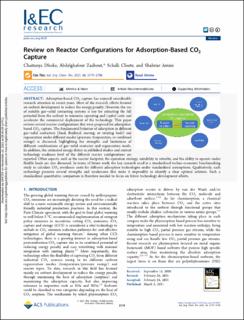| dc.contributor.author | Dhoke, Chaitanya | |
| dc.contributor.author | Zaabout, Abdelghafour | |
| dc.contributor.author | Cloete, Schalk Willem Petrus | |
| dc.contributor.author | Amini, Shahriar | |
| dc.date.accessioned | 2021-11-15T07:58:24Z | |
| dc.date.available | 2021-11-15T07:58:24Z | |
| dc.date.created | 2021-04-20T10:34:52Z | |
| dc.date.issued | 2021 | |
| dc.identifier.citation | Industrial & Engineering Chemistry Research. 2021, 60 3779-3798. | en_US |
| dc.identifier.issn | 0888-5885 | |
| dc.identifier.uri | https://hdl.handle.net/11250/2829498 | |
| dc.description.abstract | Adsorption-based CO2 capture has enjoyed considerable research attention in recent years. Most of the research efforts focused on sorbent development to reduce the energy penalty. However, the use of suitable gas–solid contacting systems is key for extracting the full potential from the sorbent to minimize operating and capital costs and accelerate the commercial deployment of the technology. This paper reviews several reactor configurations that were proposed for adsorption-based CO2 capture. The fundamental behavior of adsorption in different gas–solid contactors (fixed, fluidized, moving, or rotating beds) and regeneration under different modes (pressure, temperature, or combined swings) is discussed, highlighting the strengths and limitations of different combinations of gas–solid contactor and regeneration mode. In addition, the estimated energy duties in published studies and current technology readiness level of the different reactor configurations are reported. Other aspects, such as the reactor footprint, the operation strategy, suitability to retrofits, and the ability to operate under flexible loads are also discussed. In terms of future work, the key research need is a standardized techno-economic benchmarking study to calculate CO2 avoidance costs for different adsorption technologies under standardized assumptions. Qualitatively, each technology presents several strengths and weaknesses that make it impossible to identify a clear optimal solution. Such a standardized quantitative comparison is therefore needed to focus on future technology development efforts. | en_US |
| dc.language.iso | eng | en_US |
| dc.publisher | ACS Publications | en_US |
| dc.rights | Navngivelse 4.0 Internasjonal | * |
| dc.rights.uri | http://creativecommons.org/licenses/by/4.0/deed.no | * |
| dc.subject | Regeneration | en_US |
| dc.subject | Heat transfer | en_US |
| dc.subject | Adsorption | en_US |
| dc.subject | Sorbents | en_US |
| dc.subject | Environmental pollution | en_US |
| dc.title | Review on reactor configurations for adsorption-based CO2 capture | en_US |
| dc.type | Peer reviewed | en_US |
| dc.type | Journal article | en_US |
| dc.description.version | publishedVersion | en_US |
| dc.rights.holder | ©2021 The Authors. Published by American Chemical Society | en_US |
| dc.source.pagenumber | 3779-3798 | en_US |
| dc.source.volume | 60 | en_US |
| dc.source.journal | Industrial & Engineering Chemistry Research | en_US |
| dc.source.issue | 10 | en_US |
| dc.identifier.doi | 10.1021/acs.iecr.0c04547 | |
| dc.identifier.cristin | 1905234 | |
| cristin.ispublished | true | |
| cristin.fulltext | original | |
| cristin.qualitycode | 2 | |

